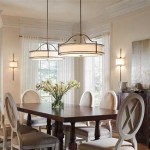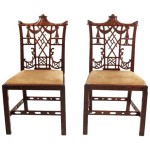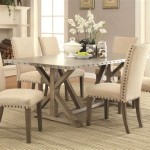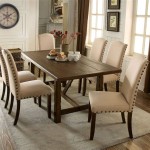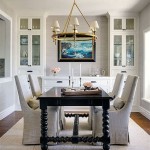Here's an article on choosing the best wall color for a dining room, structured as requested:
The Best Wall Color for a Dining Room: A Comprehensive Guide
Selecting the ideal wall color for a dining room is a critical design decision that impacts not only the aesthetic appeal of the space but also the ambiance created during meals and gatherings. The psychological effects of color are well-documented, and understanding these effects, along with considering the room's existing elements and intended purpose, is paramount in making an informed choice. This article explores the key factors to consider when choosing the best wall color for a dining room, providing a comprehensive guide to color psychology, design considerations, and specific color recommendations.
Understanding the Psychology of Color in Dining Rooms
Color psychology plays a significant role in how individuals perceive and interact with a space. Certain colors evoke specific emotions and associations, influencing appetite, mood, and conversation. In a dining room, the goal is often to create a welcoming and comfortable atmosphere conducive to enjoying meals and fostering social interaction.
Red, for instance, is often associated with energy, excitement, and stimulation. While it can be an appetite stimulant, excessive use of red in a dining room may lead to feelings of anxiety or restlessness. A more subdued shade of red, such as a deep burgundy or terracotta, might be a more suitable option.
Yellow and orange are warm, cheerful colors that can promote feelings of happiness and optimism. These colors are often associated with food and can be particularly effective in creating an inviting atmosphere. However, bright yellows can also be overwhelming, so opting for softer, muted tones like a buttery yellow or a warm apricot is often recommended.
Green is a color frequently linked to nature, health, and tranquility. It can bring a sense of freshness and balance to a dining room. Lighter greens, such as sage or mint, create a calming environment, while deeper greens, like emerald or forest green, can add sophistication and depth. Green is generally considered a versatile and agreeable color for dining spaces.
Blue is often associated with calmness, relaxation, and serenity. However, it can also suppress appetite in some individuals. If blue is desired, it's best to choose warmer shades of blue, such as teal or aqua, and to balance it with warm accents like wood tones and warm-colored artwork. Avoid overly cool or dark blues, as they can make the room feel sterile and uninviting.
Purple, particularly in lighter shades like lavender or lilac, can create a sophisticated and elegant atmosphere. Deeper purples, like eggplant or plum, can add drama and richness. When using purple, it's important to consider the overall lighting and décor, as it can sometimes appear gloomy in poorly lit spaces.
Neutral colors, such as white, gray, beige, and cream, offer versatility and sophistication. White can create a clean and airy feel, but it can also feel stark if not balanced with warmer elements. Gray is a popular choice for modern dining rooms, providing a sophisticated and neutral backdrop for other design elements. Beige and cream offer warmth and comfort, creating a welcoming and inviting atmosphere. When using neutral colors, consider adding texture and visual interest through artwork, textiles, and lighting.
Key Design Considerations for Dining Room Wall Colors
Beyond the psychological impact of color, several practical design considerations should influence the selection of a dining room wall color. These factors include the size and shape of the room, the existing furniture and décor, the amount of natural light, and the desired style and ambiance.
Room Size and Shape: Lighter colors tend to make a room feel larger and more open, while darker colors can make a room feel smaller and more intimate. In a small dining room, using lighter shades can help to maximize the sense of space. Conversely, in a large dining room, darker colors can create a more cozy and intimate atmosphere. For rooms with unusual shapes or architectural features, consider using color to highlight or camouflage specific elements. For example, painting an accent wall can draw attention to a focal point, while using a consistent color throughout can help to unify a disjointed space.
Existing Furniture and Décor: The wall color should complement the existing furniture, flooring, and décor in the dining room. Consider the color palette of the upholstery, rugs, artwork, and other decorative elements. If the furniture is brightly colored or patterned, a neutral wall color may be the best choice to avoid overwhelming the space. Conversely, if the furniture is neutral, the walls can be painted in a bolder color to add visual interest. Pay attention to the undertones of the existing elements. For example, if the furniture has warm undertones, choose a wall color with warm undertones to create a cohesive look.
Natural Light: The amount of natural light in the dining room significantly affects how the wall color appears. In a room with abundant natural light, colors will appear brighter and more vibrant. In a room with limited natural light, colors may appear darker and more muted. Before making a final decision, test paint samples on the walls and observe how they look at different times of day. Consider using lighter colors in rooms with limited natural light to help brighten the space. Conversely, in rooms with abundant natural light, darker colors can be used to create a more dramatic effect.
Desired Style and Ambiance: The wall color should reflect the desired style and ambiance of the dining room. For a formal dining room, consider using sophisticated colors like gray, navy, or burgundy. For a casual dining room, consider using brighter, more cheerful colors like yellow, green, or turquoise. Think about the overall mood that is desired. A romantic dinner may call for warmer, more subdued tones, while a family gathering might benefit from brighter, more energetic colors. Consider the style of the home as well. A traditional home may lend itself to classic colors like cream, beige, or sage green, while a modern home may be better suited to more contemporary colors like gray, white, or black.
Specific Color Recommendations and Combinations
While personal preferences play a significant role, certain colors consistently perform well in dining room settings. These colors offer a balance of aesthetic appeal, psychological impact, and design versatility.
Warm Grays: Warm grays, such as greige or taupe, are excellent choices for creating a sophisticated and versatile backdrop. These colors work well with a variety of furniture styles and color palettes. They provide a neutral base that allows other design elements to shine while adding a touch of warmth and depth. Warm grays are particularly effective in dining rooms with limited natural light, as they reflect light without feeling cold or sterile.
Sage Green: Sage green is a calming and refreshing color that brings a touch of nature indoors. It's a versatile choice that works well in both formal and informal dining rooms. Sage green pairs well with natural wood tones, creating a warm and inviting atmosphere. It's also a great choice for creating a cohesive transition between the dining room and other living spaces.
Creamy Whites: Creamy whites are classic choices for creating a bright and airy dining room. They reflect light beautifully, making the room feel larger and more open. Creamy whites provide a neutral backdrop that allows the furniture and décor to take center stage. They also work well with a variety of accent colors, allowing for flexibility in decorating. Ensure the shade of white complements existing trim and other fixed elements in the room.
Terracotta: Terracotta is a warm and earthy color that evokes feelings of comfort and hospitality. It's a great choice for creating a cozy and inviting dining room. Terracotta pairs well with natural materials like wood and stone, creating a rustic and organic feel. It's also a good choice for dining rooms with limited natural light, as it adds warmth and depth to the space.
Navy Blue: Navy blue can be a striking and sophisticated choice for a dining room. It adds a touch of drama and elegance while still maintaining a sense of calm and serenity. Navy blue works well in both formal and informal dining rooms, depending on the accents and décor. It pairs well with gold or brass accents, creating a luxurious and timeless look. When using navy blue, ensure the room has adequate lighting to prevent it from feeling too dark.
Color Combinations: Consider using color combinations to create visual interest and depth in the dining room. For example, pairing a warm gray with a soft white can create a sophisticated and inviting atmosphere. Combining sage green with natural wood tones and pops of terracotta can create a warm and organic feel. Pairing navy blue with gold accents and creamy white trim can create a luxurious and timeless look. When choosing color combinations, consider the overall style and ambiance desired.

The Best Dining Room Paint Color
:max_bytes(150000):strip_icc()/MaryPatton_May2020-6-8e9f410c0f1d4fe28484853ea47b1d5c.jpg?strip=all)
40 Perfect Dining Room Colors For Any Style
:strip_icc()/cdn.cliqueinc.com__cache__posts__209952__if-you-do-this-one-thing-you-dont-need-to-redecorate-your-dining-room-1997706-1480544442.700x0c-7744b38e1e3c4806bd6da128e6d789b6.jpg?strip=all)
The 12 Best Dining Room Paint Colors

The Best Beamin Moore Dining Room Paint Colors

10 Dining Room Paint Colour Ideas Beamin Moore

The Best Dining Room Paint Color

20 Best Dining Room Colours To Consider In 2024

Best Dining Room Paint Colours For Your Home Designcafe

The Best Dining Room Paint Color
:strip_icc()/cdn.cliqueinc.com__cache__posts__209952__-1997710-1480548645.700x0c-ffd27262ea46494e8ea323d030fb7769.jpg?strip=all)
The 12 Best Dining Room Paint Colors



